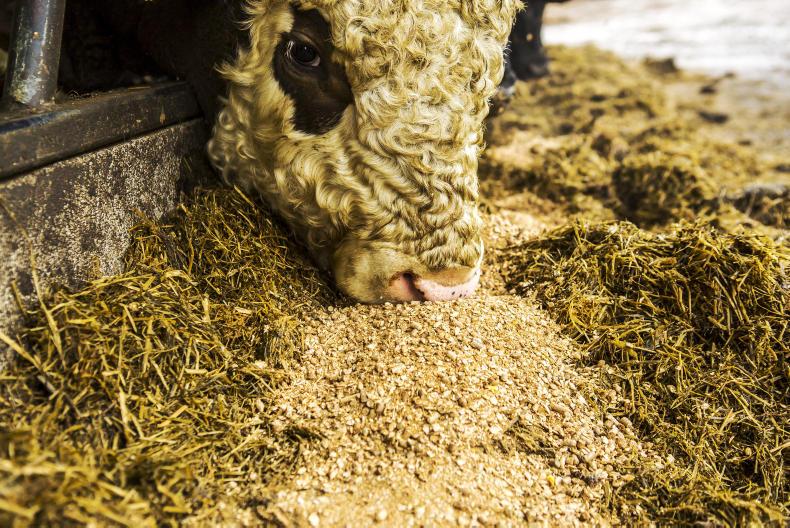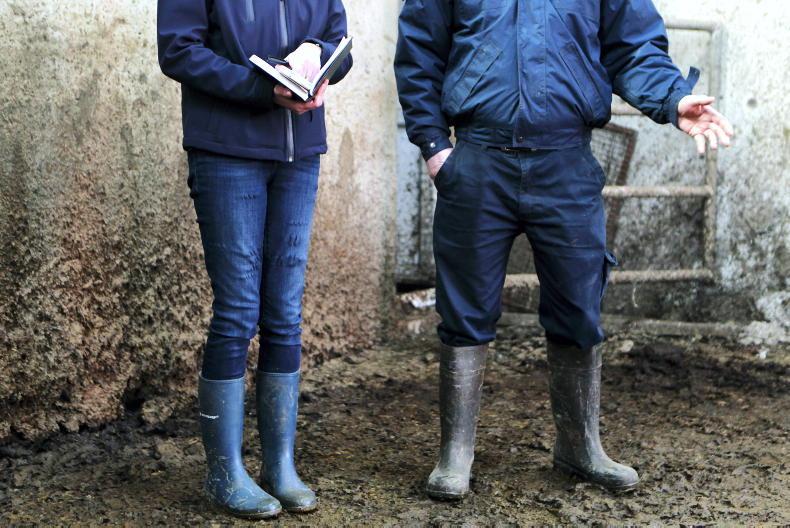The draft details of the Beef Exceptional Aid Measure (BEAM) scheme were announced last week by Minister for Agriculture Michael Creed and include a number of conditions that a farmer has to meet. These include membership of:
A Bord Bia quality assurance scheme,Or
A DAFM agri-environmental scheme.Farmers must also:
Reduce the level of production of bovine livestock manure nitrogen per farm by 5%.Membership of a Bord Bia Quality Assurance scheme must be attained by the time of application or before any payment issues. The scheme is targeted towards beef farmers and the details released by the Department of Agriculture on farmer eligibility proposals include:
Having a valid herd number with eligible bovine animalsBPS application submitted in 2018.Dairy herds will not be eligible for the scheme and dealer or agent herds will also be ineligible.
The Irish Farmers Journal understands that once a farmer is identified as a co-op supplier he or she will be excluded from the scheme.
Eligible animals
Bovine animals (older than 12 months of age) sent to slaughter in a reference period from the week beginning 24 September 2018 to the week beginning 6 May 2019.Suckler cows with progeny born between 1 January 2018 and 31 December 2018.Cull cows including Friesians are eligible for payment as long as they were slaughtered out of a beef herd.
Payment rates
Up to a maximum of 40 suckler cows with progeny born in 2018 at €40/head, and/orUp to a maximum of 100 bovine animals older than 12 months sent for slaughter during the reference period at a payment rate of €100/head.The maximum payment per farm will be €11,600 where at least 40 sucklers calved in 2018 and 100 animals were finished between the reference dates.
The average payment on suckler-to-weanling farms will be €553, while the average payment on finishing farms will be €1,819 per herd, if all eligible farms apply for the scheme. It is unclear as to what will happen to the scheme payment rates if it is undersubscribed.
How can I reduce my nitrogen output by 5%?
One of the conditions of the scheme is to reduce organic nitrogen output per farm by 5%, based on a defined reference period chosen by the Department of Agriculture.
The reference period that the Department will use for nitrogen calculation is not yet known. The Irish Farmers Journal understands that exporting slurry or renting additional land will not be deemed as a reduction in total nitrogen output. Here, we look at some different farm scenarios based on calendar year nitrogen production and how the reduction of 5% will affect each farm.
Farm one
A farmer with an average of 25 cows calving in March/April and selling weanlings at eight months in October/November produces 2,025kg of nitrogen in the calendar year. A reduction of 5% means that the farm must reduce nitrogen by 101.2kg. The options in this system are to reduce cow numbers by two, to 23 cows, or sell calves just over two months earlier, which would not be practical in a weanling system.
Farm two
A farm with 50 suckler cows finishing heifers at 20 months and steers at 24 months produces 6,890kg of organic N annually. A 5% reduction means a 344.5kg reduction. The options for this farm are to reduce cow numbers by five or finish steers at 21 months as opposed to 24 months.
Farm three
A farm buying Aberdeen Angus cross heifers at 14 months in April and finishing at 20 months in October produces 1,800kg of nitrogen so a 5% reduction is 90kg. The option is to purchase three fewer heifers. Finishing heifers in this system one month earlier is not practical, so reducing numbers is the only option.
Farm four
A farm with 50 suckler cows and one stock bull finishing continental bulls at 16 months and heifers at 20 months produces 4,137kg of organic nitrogen. A 5% reduction means a reduction of 207kg. A cow produces 65kg of nitrogen annually so it means keeping three fewer cows on the farm. Reducing the finishing age in a 16-month bull or 20-month heifer system is not practical.
Why was this reference period chosen?
The fund was applied for due to the poor beef price that beef finishers have had to take from autumn 2018 to spring 2019 due to a variety of factors including Brexit uncertainty. Animals slaughtered outside of these dates will not be eligible. The date for the closure for the reference period was chosen as the week commencing 6 May as the scheme was publicly announced around this date.
What do I need to do now?
The Irish Government will have to notify the European Commission by 31 July as to the measures being taken in the scheme. Application forms will be available and farmers will need to apply to be accepted into the scheme. Payment will be issued in due course based on numbers of cattle but may be clawed back at a later date if some or all of the criteria for the scheme are not met.
Read more
Beef price update: signs of bull throughput slowing
Positive results from first BEEP weighings
Homebred clause should be introduced to BEAM
The draft details of the Beef Exceptional Aid Measure (BEAM) scheme were announced last week by Minister for Agriculture Michael Creed and include a number of conditions that a farmer has to meet. These include membership of:
A Bord Bia quality assurance scheme,Or
A DAFM agri-environmental scheme.Farmers must also:
Reduce the level of production of bovine livestock manure nitrogen per farm by 5%.Membership of a Bord Bia Quality Assurance scheme must be attained by the time of application or before any payment issues. The scheme is targeted towards beef farmers and the details released by the Department of Agriculture on farmer eligibility proposals include:
Having a valid herd number with eligible bovine animalsBPS application submitted in 2018.Dairy herds will not be eligible for the scheme and dealer or agent herds will also be ineligible.
The Irish Farmers Journal understands that once a farmer is identified as a co-op supplier he or she will be excluded from the scheme.
Eligible animals
Bovine animals (older than 12 months of age) sent to slaughter in a reference period from the week beginning 24 September 2018 to the week beginning 6 May 2019.Suckler cows with progeny born between 1 January 2018 and 31 December 2018.Cull cows including Friesians are eligible for payment as long as they were slaughtered out of a beef herd.
Payment rates
Up to a maximum of 40 suckler cows with progeny born in 2018 at €40/head, and/orUp to a maximum of 100 bovine animals older than 12 months sent for slaughter during the reference period at a payment rate of €100/head.The maximum payment per farm will be €11,600 where at least 40 sucklers calved in 2018 and 100 animals were finished between the reference dates.
The average payment on suckler-to-weanling farms will be €553, while the average payment on finishing farms will be €1,819 per herd, if all eligible farms apply for the scheme. It is unclear as to what will happen to the scheme payment rates if it is undersubscribed.
How can I reduce my nitrogen output by 5%?
One of the conditions of the scheme is to reduce organic nitrogen output per farm by 5%, based on a defined reference period chosen by the Department of Agriculture.
The reference period that the Department will use for nitrogen calculation is not yet known. The Irish Farmers Journal understands that exporting slurry or renting additional land will not be deemed as a reduction in total nitrogen output. Here, we look at some different farm scenarios based on calendar year nitrogen production and how the reduction of 5% will affect each farm.
Farm one
A farmer with an average of 25 cows calving in March/April and selling weanlings at eight months in October/November produces 2,025kg of nitrogen in the calendar year. A reduction of 5% means that the farm must reduce nitrogen by 101.2kg. The options in this system are to reduce cow numbers by two, to 23 cows, or sell calves just over two months earlier, which would not be practical in a weanling system.
Farm two
A farm with 50 suckler cows finishing heifers at 20 months and steers at 24 months produces 6,890kg of organic N annually. A 5% reduction means a 344.5kg reduction. The options for this farm are to reduce cow numbers by five or finish steers at 21 months as opposed to 24 months.
Farm three
A farm buying Aberdeen Angus cross heifers at 14 months in April and finishing at 20 months in October produces 1,800kg of nitrogen so a 5% reduction is 90kg. The option is to purchase three fewer heifers. Finishing heifers in this system one month earlier is not practical, so reducing numbers is the only option.
Farm four
A farm with 50 suckler cows and one stock bull finishing continental bulls at 16 months and heifers at 20 months produces 4,137kg of organic nitrogen. A 5% reduction means a reduction of 207kg. A cow produces 65kg of nitrogen annually so it means keeping three fewer cows on the farm. Reducing the finishing age in a 16-month bull or 20-month heifer system is not practical.
Why was this reference period chosen?
The fund was applied for due to the poor beef price that beef finishers have had to take from autumn 2018 to spring 2019 due to a variety of factors including Brexit uncertainty. Animals slaughtered outside of these dates will not be eligible. The date for the closure for the reference period was chosen as the week commencing 6 May as the scheme was publicly announced around this date.
What do I need to do now?
The Irish Government will have to notify the European Commission by 31 July as to the measures being taken in the scheme. Application forms will be available and farmers will need to apply to be accepted into the scheme. Payment will be issued in due course based on numbers of cattle but may be clawed back at a later date if some or all of the criteria for the scheme are not met.
Read more
Beef price update: signs of bull throughput slowing
Positive results from first BEEP weighings
Homebred clause should be introduced to BEAM









SHARING OPTIONS